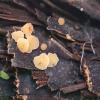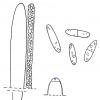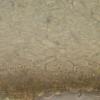
07-01-2026 22:22
 Danny Newman
Danny Newman
Tatraea sp. on indet. hardwood The Swag, Great Sm

07-01-2026 17:29
 Marc Detollenaere
Marc Detollenaere
Dear Forum,On a barkless Populus I found some smal

10-11-2021 17:33
 Riet van Oosten
Riet van Oosten
Add-on topic http://www.ascofrance.com/forum/7059

07-01-2026 10:24
 Danny Newman
Danny Newman
Pezicula sp. on indet. hardwood Appalachian Highl

07-01-2026 10:05
 Danny Newman
Danny Newman
cf. Chaetospermum on XylariaCosby Campground, Grea

02-01-2026 17:43
MARICEL PATINOHi there, although I couldn't see the fruitbody, I

04-01-2026 17:45
 Stephen Martin Mifsud
Stephen Martin Mifsud
I was happy to find these orange asmocyetes which
Hymenoscyphus aff. fulvidulus
Nicolas VAN VOOREN,
18-10-2009 20:49
 Bonjour.
Bonjour.Je vous soumets cette récolte effectuée en Corse, sur cône mort de Pinus nigra ssp. laricio.
Apothécies courtement stipitées, Ø 1-3 mm, à hyménium jaune-beige, rougissant dans les blessures ; surface externe concolore, glabre.
Asques sans crochet, 75-92 x 7-8 µm, anneau apical IKI+ (bb). Paraphyses emplies de VBs. Spores elliptiques allongées ou ± ciboroïdes, 12-18 x 3,8-4,2 (4,5) µm, guttulées, avec une cloison sur les spores les plus mûres (hors asque). Excipulum médullaire de textura intricata ; excipulum ectal de textura angularis, mêlé de cellules plus allongées, dont certaines contiennent des VBs.
Il me semble que l'espèce la plus proche serait H. fulvidulus (= Pachydisca fulvidula) mais la teinte semble plus pâle, les spores plus petites, avec une guttulation moins importante.
Qu'en pensez-vous ?
Hans-Otto Baral,
18-10-2009 23:26

Re:Hymenoscyphus aff. fulvidulus
Hi Nicolas
H. fulvidulus has much larger oil drops in the spores. The only idea I have is H. lutescens, but that species I saw only with croziers. Difficult to say. The ectal excipulum would perhaps help, is it angularis almost until margin? Oh I see that lutescens is also excluded because of a t. prismatica on lower flanks:
H. fulvidulus has much larger oil drops in the spores. The only idea I have is H. lutescens, but that species I saw only with croziers. Difficult to say. The ectal excipulum would perhaps help, is it angularis almost until margin? Oh I see that lutescens is also excluded because of a t. prismatica on lower flanks:





